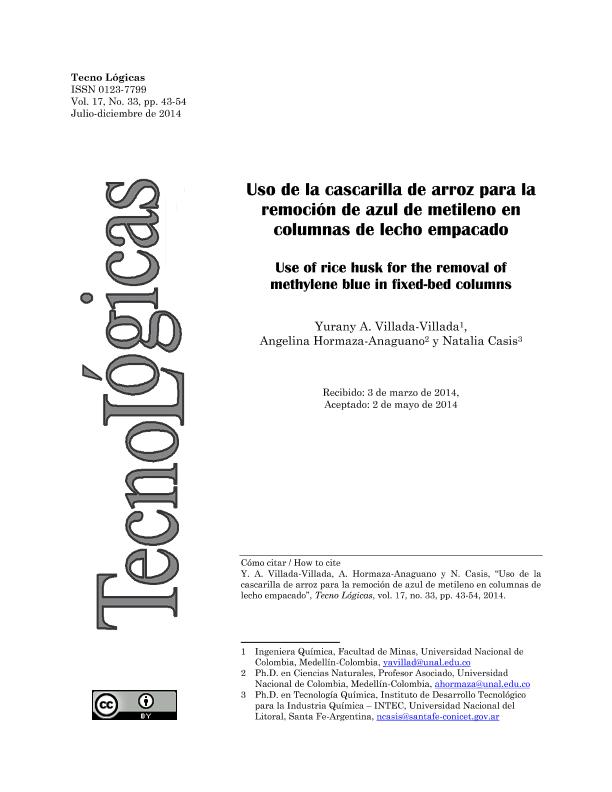Mostrar el registro sencillo del ítem
dc.contributor.author
Villada Villada, Yurany Andrea

dc.contributor.author
Hormaza Anaguano, Angelina del Socorro
dc.contributor.author
Casis, Natalia

dc.date.available
2016-12-12T20:55:41Z
dc.date.issued
2014-07
dc.identifier.citation
Villada Villada, Yurany Andrea; Hormaza Anaguano, Angelina del Socorro; Casis, Natalia; Uso de la cascarilla de arroz para la remoción de azul de metileno en columnas de lecho empacado; Instituto Tecnológico Metropolitano; Tecnológicas; 17; 33; 7-2014; 43-54
dc.identifier.issn
0123-7799
dc.identifier.uri
http://hdl.handle.net/11336/9191
dc.description.abstract
This work shows the use of rice husk in the removal of cationic dye methylene blue on continuous system. A factorial design 23 with center points and random distribution was implemented to evaluate the correlation of the experimental factors in the adsorption process. The considered variables were pH, particle size, salt presence, flow rate, dye initial concentration and bed depth. The samples were analyzed in defined time intervals. The amount of removed dye was quantified by UV spectroscopy - Visible. Adams-Bohart, Thomas and BDST (Bed-depht/service time analysis) models were used to predict the breakthrough curves using non-linear regression and establish the characteristic parameters of the process. It was found that the transference of dye toward the adsorbent is favored by a basic pH, a small particle size, low flow rate and dye concentration and high bed depth. The design of experiments established that the initial dye concentration and the bed depth were the most significant factors. Regarding the models, the Thomas provided the best fit to describe the breakthrough curves in experimental conditions and Adams-Bohart was found suitable for dynamic behavior limited to the initial part. Finally, BDST model exhibited a good correlation and allowed to establish that bed depth is a determinant factor for scaling process.
dc.description.abstract
This work shows the use of rice husk in the removal of cationic dye methylene blue on continuous system. A factorial design 23 with center points and random distribution was implemented to evaluate the correlation of the experimental factors in the adsorption process. The considered variables were pH, particle size, salt presence, flow rate, dye initial concentration, and bed depth. The samples were analyzed in defined time intervals. The amount of removed dye was quantified by UV spectroscopy - Visible. Adams-Bohart, Thomas and BDST (Bed-depht/service time analysis) models were used to predict the breakthrough curves using non-linear regression and establish the characteristic parameters of the process. It was found that the transference of dye toward the adsorbent is favored by a basic pH, a small particle size, low flow rate and dye concentration, and high bed depth. The design of experiments established that the initial dye concentration and the bed depth were the most significant factors. Regarding the models, the Thomas provided the best fit to describe the breakthrough curves in experimental conditions and Adams-Bohart was found suitable for dynamic behavior limited to the initial part. Finally, BDST model exhibited a good correlation and allowed to establish that bed depth is a determinant factor for scaling process
dc.format
application/pdf
dc.language.iso
spa
dc.publisher
Instituto Tecnológico Metropolitano
dc.rights
info:eu-repo/semantics/openAccess
dc.rights.uri
https://creativecommons.org/licenses/by-nc-sa/2.5/ar/
dc.subject
Adsorción en Columna
dc.subject
Altura de Lecho
dc.subject
Colorante Catiónico
dc.subject
Curva de Ruptura
dc.subject.classification
Otras Ciencias de la Tierra y relacionadas con el Medio Ambiente

dc.subject.classification
Ciencias de la Tierra y relacionadas con el Medio Ambiente

dc.subject.classification
CIENCIAS NATURALES Y EXACTAS

dc.title
Uso de la cascarilla de arroz para la remoción de azul de metileno en columnas de lecho empacado
dc.type
info:eu-repo/semantics/article
dc.type
info:ar-repo/semantics/artículo
dc.type
info:eu-repo/semantics/publishedVersion
dc.date.updated
2016-12-12T13:48:06Z
dc.journal.volume
17
dc.journal.number
33
dc.journal.pagination
43-54
dc.journal.pais
Colombia

dc.journal.ciudad
Medellín
dc.description.fil
Fil: Villada Villada, Yurany Andrea. Consejo Nacional de Investigaciones Científicas y Técnicas. Centro Científico Tecnológico Santa Fe. Instituto de Desarrollo Tecnológico para la Industria Química (i); Argentina. Universidad Nacional de Colombia; Colombia
dc.description.fil
Fil: Hormaza Anaguano, Angelina del Socorro. Universidad Nacional de Colombia; Colombia
dc.description.fil
Fil: Casis, Natalia. Consejo Nacional de Investigaciones Científicas y Técnicas. Centro Científico Tecnológico Santa Fe. Instituto de Desarrollo Tecnológico para la Industria Química (i); Argentina
dc.journal.title
Tecnológicas
dc.relation.alternativeid
info:eu-repo/semantics/altIdentifier/url/http://itmojs.itm.edu.co/index.php/tecnologicas/article/view/600
Archivos asociados
